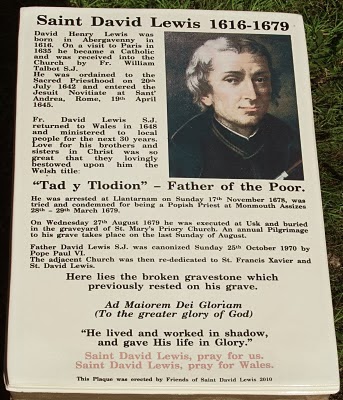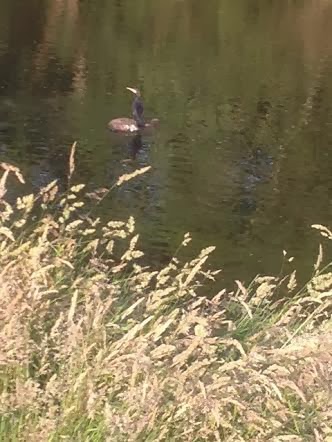 "An agreeable walk leads under the first arch of the bridge to the Abergavenny road, through a meadow planted with large walnut trees, by the side of the limpid and murmuring Usk"
"An agreeable walk leads under the first arch of the bridge to the Abergavenny road, through a meadow planted with large walnut trees, by the side of the limpid and murmuring Usk"
Archdeacon William Coxe 1801
I am very fortunate to live just a few steps away from the lovely 'Conigar Walk', a short length of footpath which runs alongside the banks of the River Usk, between Porthycarne Street and Usk Bridge. I walk this path almost everyday with my dogs before going to work. It's a great tranquil start to the day walking by the river - early mornings are a good time to see wildlife on the river but the path gets very busy in the summer, with local people and tourists enjoying a walk, sunbathing and a picnic on the river bank. Today there are willow, sweet chesnut and horse chesnut trees on the walk rather than the walnut trees that were there in Coxe's time!
Although as the quote above indicates, a riverside walk through the meadow from Usk Bridge was obviously in existence at the time William Coxe was writing in 1801, the 'Conigar Walk' was formally created in 1856 by local business men J.H. Clark and Thomas Dunn, and opened in 1858, to mark and commemorate, the marriage of Victoria, Princess Royal to Prince Frederick of Prussia.
As the blue Civc Society, information plaques at either end of the Conigar Walk indicate, the name 'Conigar' is thought to be derived from the word 'coney', denoting a rabbit warren. But equally it could also be derived from the Welsh name for rabbit 'cwningen'- which would still link the area to its use as a rabbit warren in medieval times, providing rabbits for food.
Walking the Conigar
 You can join the Conigar Walk from Porthycarne Street (Abergavenny Road) near Usk Vets or from Bridge Street near Usk Bridge. Both ends are way marked and have information plaques. Pictured here is the Porthycarne Street entrance to the walk. You can also join the path from Conigar Crescent or from the river bank when walking under Usk Bridge.
You can join the Conigar Walk from Porthycarne Street (Abergavenny Road) near Usk Vets or from Bridge Street near Usk Bridge. Both ends are way marked and have information plaques. Pictured here is the Porthycarne Street entrance to the walk. You can also join the path from Conigar Crescent or from the river bank when walking under Usk Bridge.
Walking towards Usk Bridge from Porthycarne Street entrance
Looking from The Conigar Walk towards the old railway bridge over the River Usk
View of The Conigar Walk from Usk Bridge

The approach to the Conigar path from Usk Bridge/ Bridge Street
The Conigar Walk circa 1960
 |
| Post cards from the Francis Frith collection |
As you walk along The Conigar path it is hard in this sublime location, to think that you are very near the site of an extremely grisly excecution that took place 335 years ago. A sign post from the path points you up the flood defence bank to the location of the 'St David Lewis Plaque'.
As you walk down the path into Conigar Crescent, you will see on your left through the fence, in the grounds of Porthycarne House, a plaque marking the site of the gallows where St David Lewis was executed in 1679.
 |
| David Lewis |
Between 1678 and 1681 a totally fictitious but widely believed plot emerged, in which it was alleged that Jesuits were planning the assassination of King Charles II in order to bring his Roman Catholic brother, the Duke of York (afterward King James II), to the throne. The 'Popish Plot' was fabricated by Titus Oates, a renegade Anglican clergyman.
Like other Catholic priests of the time David Lewis found shelter in safe houses where he secretly celebrated Mass and the Sacraments. It is well documented that he stayed in the home of Thomas Gunter in Abergavenny and he also practiced mass in a house in Usk - what is now the Crosskeys pub. He also found refuge at the home of his aunt, Lady Frances Morgan, at Llantarnam. It was here in November 1678 he was arrested by six armed men and taken to Monmouth Gaol and then later transferred to Usk Gaol to await trial in Monmouth assize court. Joseph Bradney describes events:
 |
| The site of the old Usk Gaol in Bridge Street where David Lewis was held prior to execution |
Jeremy Knight records that the execution of David Lewis was carried out in Usk rather than Monmouth because it was thought that Usk was less of a Catholic stronghold than Monmouth and that there would be less opposition. It appears however that many of the townspeople of Usk had sympathy for the cause of David Lewis. Carpenters apparently refused to build the gallows and the executioner allegedly ran away and a prisoner had to be bribed to carry out the grisly task. Many of the crowd that gathered to watch the execution, knelt during the sermon David Lewis preached prior to it being carried out and a lay preacher held his hand and prevented him being cut down from the gallows until he was dead. Normally with this type of execution, the disemboweling would have taken place while he were still alive and then the body would have been chopped up and its parts displayed in various locations. An execution of this type would have been very much like the horrific scene in the film 'Braveheart' (beware if you decide to watch it, the link I've provided to that scene in Braveheart is quite graphic) where William Wallace is hung, drawn and quartered. David Lewis' body was spared this treatment and it was carried in a respectful manner for burial at St Mary's Priory Church.
David Lewis wrote an account of his own trial before he was executed at Usk on 27 August 1679. He was beatified in 1929 and Canonised as one of the Forty Martyrs of England and Wales in 1970.
 |
| Church of SS David Lewis and Francis Xavier |
 |
| The shrine to David Lewis in the Church of SS David Lewis and Francis Xavier |
 |
Know as 'Tad y Tlodion' - 'Father of the Poor'', David Lewis was the last Welsh Martyr. It is hard to believe that such significant but dreadful things happened here by the river bank in quiet little Usk. Film script anyone???You have to acknowledge it is an amazing if rather grisly story!
 |
| The grave of St David Lewis at St Mary's Church Usk |
Although the Conigar Walk passes right alongside the site of this really horrific execution, I have never experienced any bad vibes or feeling of forboding walking along it - today, as in the nineteenth century, it is a very popular 'leisure facility' for the people of Usk and is enjoyed by many every day, at all times of the year!
3000 Watery Steps
The Conigar Walk is part of the Monmouthshire Council/ Welsh Government '3000 Watery Steps' walking for fitness route, which uses a circular route taking in The Conigar Walk, Usk Bridge, Usk Island and the old Usk Railway bridge. There is an information board with a map showing this route at Usk Island near the old railway bridge. Download a copy of the map here
.jpg)
The Conigar Walk can be a great place to see wildlife especially at early morning and sunset
Reference Sources
A Historical Tour Through Monmouthshire - Archdeacon William Coxe 1801
A History of Monmouthshire, The Hundred of Usk - Joseph Alfred Bradney 1921
3000 Watery Steps
The Conigar Walk is part of the Monmouthshire Council/ Welsh Government '3000 Watery Steps' walking for fitness route, which uses a circular route taking in The Conigar Walk, Usk Bridge, Usk Island and the old Usk Railway bridge. There is an information board with a map showing this route at Usk Island near the old railway bridge. Download a copy of the map here
.jpg)
The Conigar footpath is a pleasant walk at any time of the year - 4 views, 4 seasons!
 |
| Photo from Usk Town website |
 |
| Swans and cygnets taken from the Conigar Walk opposite what was the old 'Britannia' pub 2013 |
 |
| Cormorant fishing taken from the Conigar Walk 2013 |
A Historical Tour Through Monmouthshire - Archdeacon William Coxe 1801
A History of Monmouthshire, The Hundred of Usk - Joseph Alfred Bradney 1921
A Portrait of Usk - Anne Leaver 1989
Early Victorian Usk - David R Lewis 1982
Usk Castle, Priory and Town - Jeremy K. Knight and Andy Johnson 2008
The Last Welsh Martyr Blogspot
Usk Civic Society - Usk Town Trail
 |
Dewi enjoying playing with his 'prize' found in the river
on our regular early morning 'Conigar Walk'
|
.jpg)













.jpg)

.jpg)

No comments:
Post a Comment